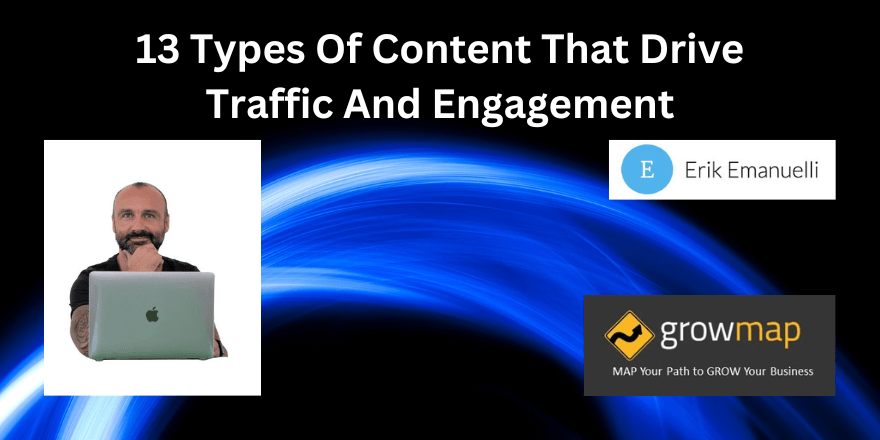Are you looking for ideas on how to create content that is both informative and engaging?
You’ve come to the right place!
This article will explore thirteen types of content that will attract the right attention and build a loyal following.
So, are you ready to improve your brand’s online presence?
Let’s dive in!
1. The Mighty Blog Post
The key to a successful blogging strategy often lies in balancing pillar and cluster content.
Pillar content acts as the foundation for your blog, covering broad topics that are then interlinked with more granular cluster content (targeting long-tail keywords).
A successful pillar post is comprehensive, high-quality, and serves as an ultimate guide on the subject.
It includes various elements like infographics, videos, and downloadable resources like fonts that provide additional value.
Examples: Medium’s famous ‘How-To’ series, HubSpot’s comprehensive marketing guides, and Backlinko’s highly detailed SEO analyses.
Tools: Use tools like SEMrush or Ahrefs to research and identify high-volume, low-competition keywords to build your pillar content. For content ideation and performance tracking, consider platforms like BuzzSumo or CoSchedule.
2. The Power Of Infographics
Infographics are powerful tools for turning complex data into easily digestible visual content.
Some effective infographic ideas include timelines, comparison charts, and process diagrams.
They are highly shareable, boost SEO rankings, and can be used as a lead generation tool.
Design Tip: keep the design simple but engaging. Use bold, high-contrast colors, clear typography, and intuitive layouts to guide the viewer’s eye through the information.
Example: Semrush’s infographic about ten tips to improve content gives a visually pleasing overview of various strategies.
Tools: Canva, Visme, or Adobe Illustrator are great for creating infographics. To find the right data, use sources like Statista or Datawrapper.
3. Mastering the Video Content
 In a digital age where the ‘how’ is just as important as the ‘why’, tutorial videos are an excellent way to provide value to your audience, which in turn improves engagement and builds trust.
In a digital age where the ‘how’ is just as important as the ‘why’, tutorial videos are an excellent way to provide value to your audience, which in turn improves engagement and builds trust.
Tip: sequence your tutorials logically, ensuring each step follows the last. Use screen recordings to give viewers a hands-on experience.
Example: ‘How to Create a WordPress Blog from Scratch’ by WPBeginner, making a seemingly complex process accessible to beginners (it counts almost 400k views).
Tools: For screencasting, Camtasia or Loom are great options. An additional tool you should use is a GIF creator like the one Adobe offers.
4. Interactive Content
If you can offer a tool that provides a specific value to your audience, you can enhance engagement significantly. This could be anything from mortgage calculators to body fat estimators.
Tip: ensure that your tool is well-presented and easy to use. The process should be quick, and the results should be both clear and actionable.
Example: HubSpot’s ‘Marketing Plan Tool’ which helps users create a personalized marketing plan by answering a series of questions about their business.
Tools: Many plugin and widget options are available depending on your CMS. Services like Zoho Creator, Formstack, or a Formstack alternative can also help build custom tools.
5. The Power of Podcasting
Hosting leaders, experts, or influencers in your industry for an interview can provide your audience with unique insights and perspectives they might not find elsewhere.
Tip: prepare ahead of time with well-researched questions and a clear structure. Engage in active listening and follow up with relevant and thought-provoking questions.
Example: ‘Authority Hacker’ podcast where the hosts interview successful online entrepreneurs and industry experts.
Tools: Use tools like Zencastr or Ringr to record high-quality audio. Services like Buzzsprout or Transistor can help with hosting and distribution.
6. Lead Magnet E-Books
Offering an e-book as a lead magnet can be a powerful tool for lead generation, particularly for B2B businesses. Create high-quality, actionable content that leaves the reader wanting more.
Tip: focus on a problem you can solve for your target audience and ensure that the types of content used are genuinely valuable. Use a compelling mix of text, images, and maybe even video to keep your reader engaged.
Example: Marketo’s ‘Definitive Guide to Lead Nurturing’ serves as an educational resource that also demonstrates the company’s expertise in the subject.
Tools: Tools like Beacon or Designrr can convert your existing content into an e-book, making it easier to distribute.
7. Whitepapers and Research Papers
Whitepapers and research papers that provide an in-depth analysis of industry trends, consumer behavior, or market data can solidify your position as an industry expert.
Tip: ensure that the information you provide is both accurate and actionable. Use professional charts, graphs, and data visualizations to present your findings in a research presentation.
Example: “The State of Link Building Industry 2023” by Smarty Marketing, which provides a comprehensive analysis of the current state and future predictions of the link-building industry.

Tools: Use Google Scholar or JSTOR to find relevant research papers and studies. Adobe InDesign or Canva can help design visually appealing whitepapers.
8. Newsjacking
Newsjacking involves creating content that leverages the buzz of a current event, news story, or trend. It can propel your content into the spotlight and engage users looking for the latest information or perspectives.
Tip: react quickly but thoughtfully. Ensure your take connects with the larger narrative while offering a unique insight.
Example: SEJ talks about Elon Musk’s Twitter takeover with the timeline of events that led to the Twitter rampage.

Tools: Google Trends and social media monitoring tools are invaluable for spotting trends and news stories as they break.
9. Interactive Storytelling
The immersive nature of AR and VR can take your storytelling to the next level by literally placing your audience inside the narrative. This emerging field has huge potential for brands that fully utilize this technology.
Tip: prioritize the narrative over the technology. Content should be compelling on its own, with AR or VR elements enhancing the experience.
Example: British Airways’ “Take a Virtual Tour” uses VR to showcase their Business Class experience.
Tools: Specialist AR/VR development agencies can bring your vision to life. Branded content does particularly well in these formats so investing in your app or experience could also be worthwhile.
10. Types of Content Roundups
These can be a great resource for your audience to stay on top of the latest industry news, best practices, or trends. They save time for your readers by doing the legwork of content curation.
Tip: provide context and your take on the content to add value. Make sure the roundups are comprehensive and on time.
Example: Diggity Marketing monthly roundup of SEO and digital marketing industry news and insights.
 Tools: Implement an RSS feed or use online services like Feedly or Flipboard to keep current with the latest types of content in your field. A dedicated newsletter platform can maintain consistency in delivery.
Tools: Implement an RSS feed or use online services like Feedly or Flipboard to keep current with the latest types of content in your field. A dedicated newsletter platform can maintain consistency in delivery.11. Evergreen Content
Create the most comprehensive resource on a topic in your industry. These types of content can take time to produce but are a long-term asset, ranking highly for targeted keywords and continually attracting traffic.
Tip: update frequently to keep it current and reflect changes and evolutions in the industry.
Example: The Moz Beginners Guide to SEO, which provides an essential resource for those starting in the field of search engine optimization.

Tools: Utilize keyword research tools to find topics that have high search volume and low competition. Ahrefs or surferSEO are perfect for this purpose.
12. Lists and Comparisons
Comparing your product or service to others in the market can help highlight its unique selling points and demonstrate how it stands out from competitors.
Tip: be honest and use data to back up your claims. Don’t shy away from mentioning areas where your product may not perform as well.
Example: The Motley Fool vs Zacks 2024, by ModestMoney, compares two popular investment research platforms to help readers make an informed decision.

Tools: Use review platforms like G2 or Capterra to find data on competing products and analyze their features. Visual comparison tools like Canva or Venngage can help create eye-catching comparisons.
13: Repurposed Content
Slides in a slide deck can often be expanded into standalone blog posts or articles. This repurposing is economical and can extend the life of the content.
Tip: ensure the standalone article provides enough context and value to make sense without the rest of the deck.
Example: Marketing presentations that are also used as the basis for white papers, articles, or webinars.
Tools: Utilize CMS systems that can easily incorporate visual content like WordPress or Squarespace. Keep a visual identity consistent across all platforms for a professional look.
Final Words
Creating a content strategy that incorporates different types of content is essential for engaging and retaining your audience.
Use the tips, examples, and tools provided in this guide to create a well-rounded content plan that will keep your audience coming back for more.
Remember to continually analyze and adapt your strategy based on metrics and feedback from your audience to ensure its effectiveness.
Use our Content Audit Success: A Step-by-Step Guide [Videos] to get started.
With dedication and creativity, you can create evergreen content that will stand the test of time and keep your brand at the forefront of your industry.

























